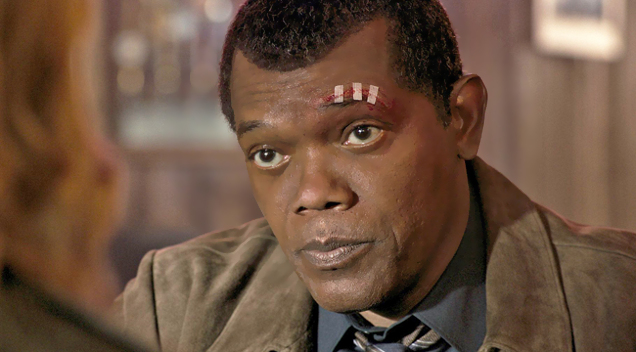Why Samuel L. Jackson’s ‘de-aged’ performance is the most interesting thing about Captain Marvel


Samuel L. Jackson was made to look 25 years younger in Captain Marvel. If you think this ‘de-ageing’ technology is a little weird, writes Luke Buckmaster, you ain’t seen nothing yet.
In the bombastic Captain Marvel, Brie Larson plays a superhero whose first notable act is a combination of time travelling and crash landing. After fisticuffs with a race of chameleon aliens, the titular character plummets through the roof of a Blockbuster Video store, discovering herself in the latest world of post-Stranger Things nostalgia-mongering. It’s the 90s: Nirvana is on the radio and The Fresh Prince of Bel-Air plays on the teev. There’s Troll dolls and pinball machines.
There is also Nick Fury, the famous character played by Samuel L. Jackson – who will become director of the intelligence agency S.H.I.E.L.D. Jackson, who is 70, has played this part in several recent films based in contemporary times (such as Avengers: Infinity War) meaning he needed to look approximately 25 years younger in Captain Marvel. To do this the actor underwent a computer-enabled ‘de-aging’ process.
Marvel has dabbled in this technology before, including Ant-Man flashback scenes depicting a young Michelle Pfeiffer and Michael Douglas. There are other examples; for instance a much younger and surreal looking Jeff Bridges in Tron: Legacy. The technology isn’t going away. We might even get a better look at it when Martin Scorsese’s new film The Irishman arrives, promising to youth-ify Robert DeNiro and Al Pacino.
It is refreshing to see a superhero movie told from a woman’s perceptive; the greasy machismo rampant in these films is one of the reasons so many of them are so bland and forgettable. Brie Larson cuts a robust, cast-iron presence, but for me the most compelling performance was Jackson’s – not because of his character, or even Jackson as an actor, but because of what happened to him in post-production.

For a little while, when I studied Jackson’s face, I struggled to decide whether I had a problem with how he looked – before determining that indeed I did, very much so, given that question never went away (my mind happily wandered into this subject, which is much more stimulating than the film itself – a clunky, directed-by-committee money-maker, designed to be crack for Marvel junkies). The human brain doesn’t mind processing fantastically far-out things: talking unicorns, say, or alien beasts with multiple faces. However when a manufactured creation is very close to being human, but not quite there, our minds reject it and freak out about the small discrepancies. This well-known concept is called the ‘uncanny valley’.
To me Jackson’s face looked too glassy, his skin like light shining off water. I was disturbed by the feeling that I couldn’t work out which bits of him were human and which were not. That sensation has some (presumably unintended) synchronicity with the contents of the film’s story, which involves a race of shapeshifting aliens called Skrulls who can take whatever human form they like, which presents to their enemies the question of who is a person and who is not. It’s also possible that knowing ahead of time that Jackson had been de-aged influenced how I felt.
In any event the outcome is the same: the de-ageing technology derailed his performance, making me ponder the genuineness of this human-ish construct. If you think this computer-warped Jackson is a bit trippy, though, you ain’t seen nothing yet. The party has barely begun. I am not referring to Scorsese’s next picture, but a series of developments that will powerfully alter the digital narratives we share and experience in the future. Change is afoot, and it’s going to be epic.
It is difficult to achieve consensus on matters involving crystal ball gazing, but there are some things almost everybody agrees on when it comes to the future of entertainment. One of them is that virtual reality will become a bigger and more popular pastime, evolving to the point where users don’t just have presence but agency. Currently when watching 360 videos, immersed audiences experience a phenomenon known as The Swayze Effect. Named after the supernatural drama Ghost, it refers to the frustration of powerlessly watching the world go by, unable to interact with it.

With agency, viewers (for want of a better word, as they will also be ‘experiencers’) will influence the direction of narratives and engage with the virtual world around them. When they talk to a character they will expect the character to talk back – like Siri or chatbots, but capable of developed conversations. The technology is already here; it just has a long way to go. Initiatives involving characters in narrative experiences who engage with viewers/experiencers have already been experimented with in VR, Oculus for instance using using live streams of real human actors in motion capture suits.
Because these initiatives require actual people, they are not scalable. But they won’t require actual people forever (and maybe not for long). The liberated role of the viewer/experiencer will come at the expense of some parts of the acting profession, such as live performance spontaneity, which in many instances will be outsourced to a computer.
For the time being, the focus of our conversations in this period of cyberdrama infancy will remain on machine-enabled alterations of human form. We’ll discuss our unusual uncanny valley experiences, as I have in this piece, or note pleasures derived from the latest motion capture-aided transformation. Visual renderings are part of the process in building the future of narrative entertainment – but far from the most important. When we look back and remember how we talked about filmmakers tinkering with the way people looked, rather than transforming the consciousness of their characters, boy oh boy will our discussions sound dated.
















